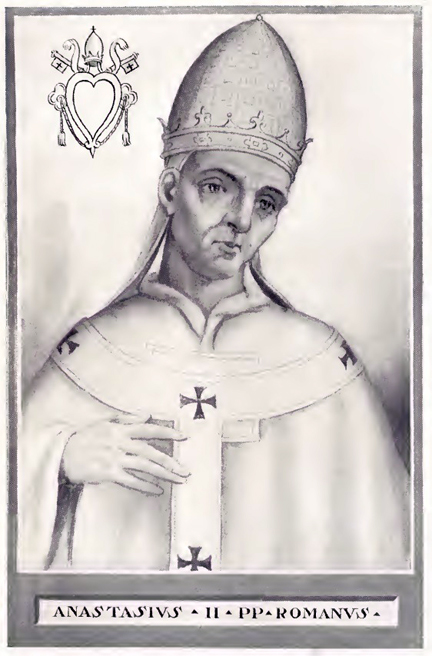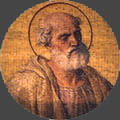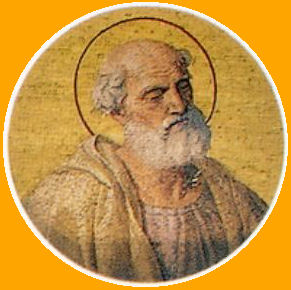











|










|
Det dynamisk skiftende indhold på denne side er sammensat af bearbejdet materiale, der fortrinsvis er inspireret af fakta fra ovenstående links. Disse links er i sig selv og i høj grad spændende og anbefalelsesværdig læsning.
Jeg påberåber mig således ingen former for ophavsret over nærværende materiale.
Jeg takker hermed for inspiration. :-)
M. Due 2025
|






|
Anastasius II - 496-498 :
Anastasius II (Sant Anastasio II)Anastasius II var pave fra 24. november 496 til 19. november 498.
Han er den anden pave siden Peter til ikke, at blive regnet som helgen efter Liberius, som var den første.
Kirkehistorikeren Richard P. McBrien mener at synet på Anastasius II som forræder i høj grad er uretfærdig eftersom han trak bandlysningen tilbage fra de gejstlige som havde fordømt hans styre.
Pope Anastasius II (died 16 November 498) was the head of the Catholic Church from 24 November 496 to his death in 498. He was an important figure trying to end Acacian schism, but his efforts resulted in the Laurentian schism, which followed his death. Anastasius was born in Rome, the son of a priest, and is buried in St. Peter's Basilica.
Acacian schism and conciliation
The church had been in a serious doctrinal dispute since 484, between the Eastern and Western churches of Christianity, known as the Acacian schism. Pope Felix III (483-492) and Pope Gelasius I (492-496) had generally taken hardline stances towards the Eastern church and had excommunicated many of the major religious figures including Acacius, the Patriarch of Constantinople. Efforts at reducing the problem by Zeno were not recognized by Felix III or Gelasius I and so there was a large schism between the churches. Upon the death of Gelasius I, Anastasius II was named pope largely with support from a faction that wanted to improve relations between the West and the Eastern churches and end the schism.
Upon being named pope, Anastasius II immediately sent two bishops to Constantinople to meet with the Byzantine Emperor Anastasius I, who had the same name as the pope, and work on an agreement to end the Acacian schism. Anastasius II indicated in a letter that he was willing to accept the baptisms that had been performed by Acacian and to let the issue be decided by the divine rather than by church authorities and Anastasius I seemed similarly willing to cooperate but wanted acceptance of the Henotikon, the compromise position developed by Zeno. As a signal of attempting to reduce the tension, Anastasius II was rumored to have given communion to Photinus, a bishop denounced by Gelasius I as an Acacian.
The result of these conciliatory gestures was to outrage many of the bishops and clergy in Rome and to create a clear division between those who supported moderation toward the Monophysites in the Byzantine Empire and those who opposed such moderation. Because of the communion with Photinus, many in Rome refused to receive communion from Anastasius II and the situation grew to a crisis point.
Death and legacy
At the peak of the tension created by these attempts to improve relations between the East and the West, Anastasius II suddenly died. For those who opposed his attempts at remedying the schism his death in 498 was seen as divine retribution. The factions that had formed during his rule as pope split decisively from one another and each appointed a rival pope. The faction against conciliation was able to name Symmachus as the pope to follow Anastasius II. However, the important Roman Senator Rufius Postumius Festus, who had been a major instigator for the conciliation attempts of Anastasius II and may have led to his naming as pope, supported a rival papal claim of Laurentius. The Roman church then had its own schism between different factions which made efforts at reducing the schism between the church in Rome and the church in Constantinople impossible.
During the medieval period, Anastasius II was often considered a traitor to the Catholic Church and an apostate. The writer of the Liber Pontificalis, supporting the opponents to Anastasius' efforts, argued that Anastasius II's death was divine retribution and that he had broken with the church. Similarly, the Decretum Gratiani writes of the pope that "Anastasius, reproved by God, was smitten by divine command." This medieval view is described by modern commentators as a "legend", a "misinterpretation", a "confused tradition", and "manifestly unjust."
Dante placed Anastasius II in the sixth circle of hell: "Anastasio papa guardo, lo qual trasse Fotin de la via dritta". However, modern Dante scholars consider this to be a mistake: the person Dante intended to put at that level was the Byzantine emperor of the time, Anastasius I. Anastasius II is, with Pope Liberius, one of only two of the first 50 popes not to attain sainthood.
Katolske begreber:
|
Ordforklaring :
Liber Pontificalis
Liber Pontificalis:[ - ]
Liber Pontificalis: eller Pavernes Bog er en af de væsentlige kilder vedrørende den tidlige middelalders historie, men den er også genstand for stor skepsis i den henseende.

På det umiddelbare plan er bogen en samling kortfattede biografiske registreringer af de første paver op til slutningen af det 10. århundrede nævnt i kronologisk rækkefølge. Hver af registreringerne består af pavens regeringstid i antal år (og herudfra kan årstallene udledes), deres fødselssted og forældre, de samtidige kejsere, indsats med hensyn til byggeri (specielt vedrørende romerske kirker), udnævnelser, vigtigste erklæringer, begravelsessted og tiden indtil næste pave var valgt og indviet. Imidlertid vanskeliggør måden, den blev til på, at man kan fæste ordentlig lid til bogen som historisk dokumentation.
Liber Pontificalis er skrevet af underordnede embedsmænd ved paveretten, og der er fundet eksempler på forvanskninger, udeladelser og forfalskninger. Registreringerne for de
første tre århundreder
er derfor nok først og fremmest interessante for historikere som eksempler på, hvad man i det 5. århundrede vidste om den tidligste katolske kirke. Fra det 4. århundrede og frem er skribenterne på mere sikker grund, selv om der stadig kan findes fejl og mangler. Granskning af teksten lader formode, at der fandtes to tidlige versioner fra før belejringen af Rom i 546, men herefter er der tale om et enkelt eksemplar. Fra begyndelsen af det 7. århundrede (omkring tiden for Pave Honorius 1.'s indsættelse) og frem indtil indsættelsen af Pave Adrian 2. er registreringerne skrevet i samtiden kort efter hver paves død og dermed rimeligt præcise, når man ser bort fra de enkelte skribenters holdninger.
Fortsættelser af Liber Pontificalis blev senere lavet og fører beretningerne om paverne videre fra omkring 1100 til midten af det 15. århundrede, men kvaliteten heraf er meget varierende.
De mange skribenters arbejde over lang tid komplicerede arbejdet med at lave udgaver af værket til videnskabelige formål. Mod slutningen af det 19. århundrede gjorde Louis Duchesne og Thodor Mommsen begge forsøget, men Mommsens udgave er dog ikke komplet. I det 20. århundrede er der udkommet oversatte og kommenterede udgaver, hvor vægten af kommentarerne har gået på den historiske troværdighed af beskrivelserne.
[ - ]
0434
|





